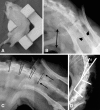In vivo and in vitro analysis of rat lumbar spine mechanics
- PMID: 20552305
- PMCID: PMC3049628
- DOI: 10.1007/s11999-010-1421-6
In vivo and in vitro analysis of rat lumbar spine mechanics
Abstract
Background: Rodent lumbar and caudal (tail) spine segments provide useful in vivo and in vitro models for human disc research. In vivo caudal models allow characterization of the effect of static and dynamic loads on disc mechanics of individual animals with time, but the lumbar models have required sacrifice of the animals for in vitro mechanical testing.
Questions/purposes: We therefore developed a novel displacement controlled in vivo lumbar spine noninvasive induced angular displacement (NIAD) test; data obtained with NIAD were used to compare angular displacement between segmental levels (L4/L5, L5/L6 and L6/S1), interobserver radiograph measurement agreement, and intraobserver radiograph measurement repeatability. Measurements from NIAD were compared with angular displacement, bending stiffness, and moment to failure measured by an in vitro test.
Methods: Anesthetized Lewis rats were xrayed in a 90° angled fixture, and NIAD was measured at lumbar levels L4 to S1 by two independent and blinded observers. After euthanasia, in vitro angular displacement (IVAD), stiffness, and failure moment were measured for the combined L4-L6 segment in four-point bending.
Results: NIAD was greater at L4/L5 and L5/L6 than at L6/S1. Combined coronal NIAD for L4-L6 was 42.8° ± 5.3° and for IVAD was 61.5° ± 3.8°. Reliability assessed by intraclass correlation coefficient (ICC) was 0.905 and 0.937 for intraobserver radiograph measurements, and interobserver ICCs ranged from 0.387 to 0.653 for individual levels. The interobserver ICC was 0.911 for combined data from all levels. Reliability for test-retest NIAD measurements had an ICC of 0.932. In vitro failure moment correlated with NIAD left bending.
Conclusions: The NIAD method yielded reproducible and reliable rat lumbar spine angular displacement measurements without required euthanasia, and allows repetitive monitoring of animals with time. For lumbar spine research studies performed during a course of time, the NIAD method may reduce animal numbers required by providing serial angular displacement measurements without euthanasia.
Clinical relevance: Improved methods to assess comparative models for disease or aging may permit enhanced clinical treatments and improved patient care.
Figures



References
-
- Beckstein JC, Sen S, Schaer TP, Vresilovic EJ, Elliott DM. Comparison of animal discs used in disc research to human lumbar disc: axial compression mechanics and glycosaminoglycan content. Spine (Phila Pa 1976) 2008;33:E166–173. - PubMed
MeSH terms
Grants and funding
LinkOut - more resources
Full Text Sources
Medical

